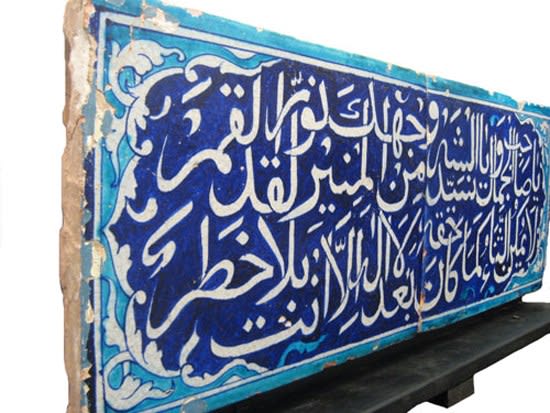Glazed Tiled Panel with Inscription, 18th Century CE
Glazed Terracotta
27.5 x 9.8
LO.637
Further images
Glazed tile of rectangular form, the light and dark blue decoration comprising an almond shaped motif containing Islamic calligraphy and surrounded by a floral pattern. The written is a verse...
Glazed tile of rectangular form, the light and dark blue decoration comprising an almond shaped motif containing Islamic calligraphy and surrounded by a floral pattern.
The written is a verse from the Holy Koran: "Oh Possessor of beauty and master of men!
From your radiant face does the moon illuminate and become illuminate Your praise can never be given it’s due right as its rights are infinite. Essentially all we’re trying to say is: After God, you are the greatest".
The first major development in the art of Islamic tile-making occurred primarily in Anatolian Seljuk architecture. Mosques, mescits (small mosques) and minarets, were decorated with turquoise and purple and reddish glazed brick to produce a variety of geometric compositions and kufic inscriptions. Small mosaic-like pieces of tile were also combined to create certain designs. Glazed brick and tile-work, similar to the decoration found on minarets, is seen on the exteriors of tombs and in the interiors of Seljuk buildings, on brick revetments covering large surfaces, on arches, vaults, walls and on other architectural elements.
Turkish tiles and pottery from the 14th to 19th centuries have won worldwide acclaim due to their wide range of techniques, colour schemes and designs.
This blue glazed tile is a perfect example of the artistic splendor of that age.
The written is a verse from the Holy Koran: "Oh Possessor of beauty and master of men!
From your radiant face does the moon illuminate and become illuminate Your praise can never be given it’s due right as its rights are infinite. Essentially all we’re trying to say is: After God, you are the greatest".
The first major development in the art of Islamic tile-making occurred primarily in Anatolian Seljuk architecture. Mosques, mescits (small mosques) and minarets, were decorated with turquoise and purple and reddish glazed brick to produce a variety of geometric compositions and kufic inscriptions. Small mosaic-like pieces of tile were also combined to create certain designs. Glazed brick and tile-work, similar to the decoration found on minarets, is seen on the exteriors of tombs and in the interiors of Seljuk buildings, on brick revetments covering large surfaces, on arches, vaults, walls and on other architectural elements.
Turkish tiles and pottery from the 14th to 19th centuries have won worldwide acclaim due to their wide range of techniques, colour schemes and designs.
This blue glazed tile is a perfect example of the artistic splendor of that age.





